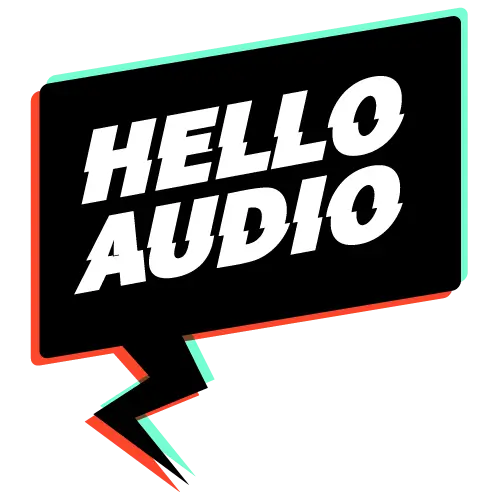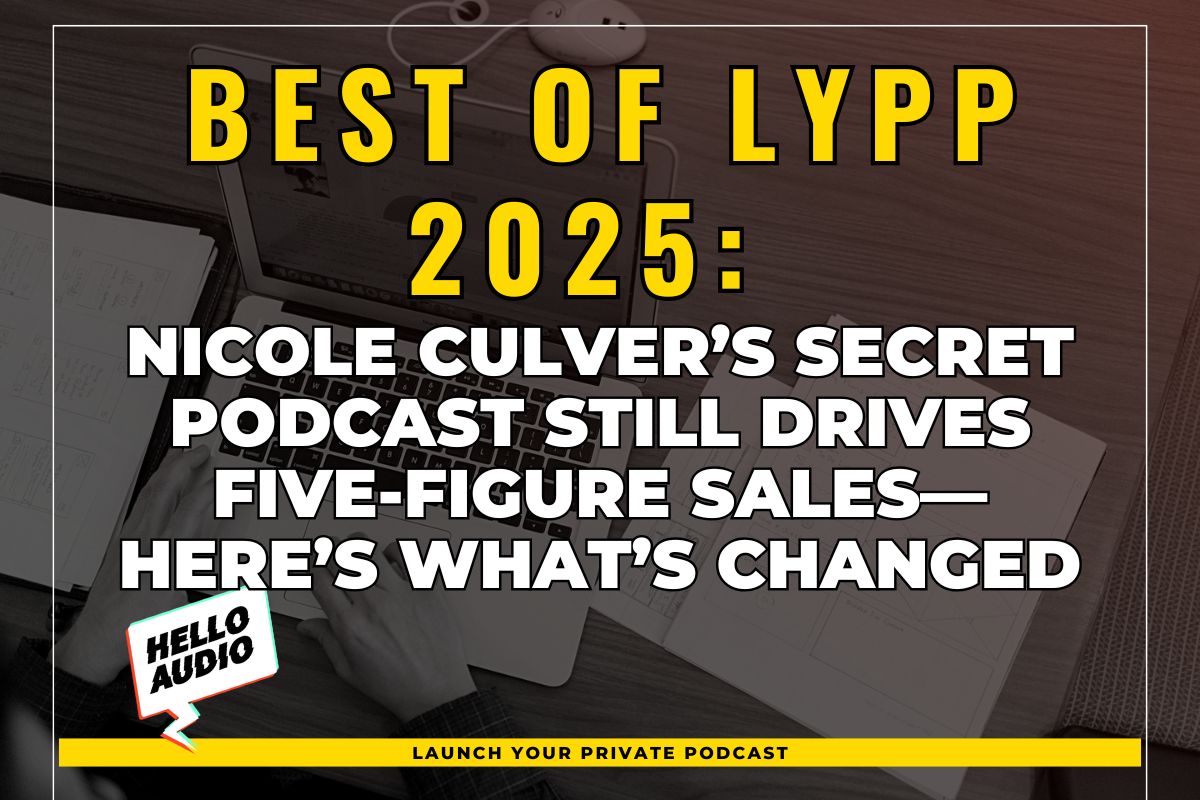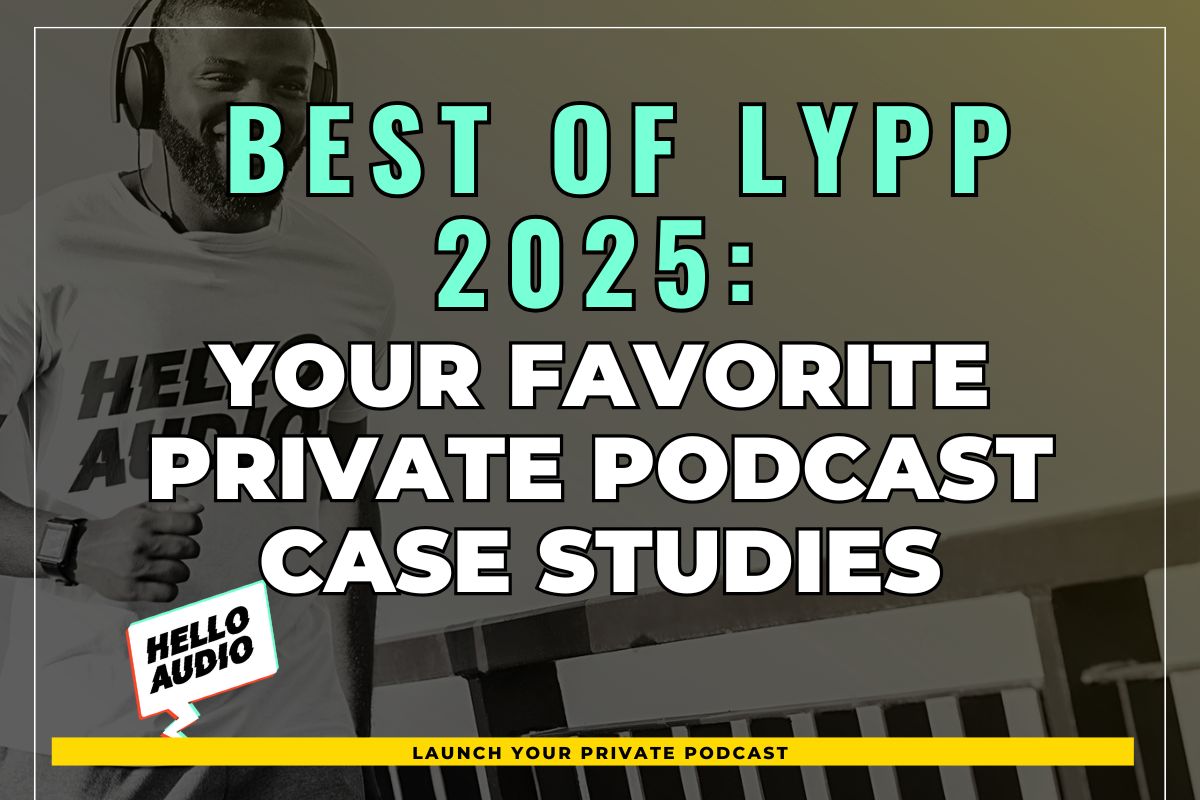If you’re a creator and want to monetize your content, you’ve probably come across the Ko-fi vs. Patreon debate. While both are popular sites, they have slightly different features and functionalities.
So, which tool should you choose?
We’ve created this comparison guide with all the details you need to know about these platforms.
TL;DR – Ko-fi vs. Patreon
Check out how the two compare (including Patreon’s pros and cons). We’ve also compared them to a third platform: Hello Audio.
| Ko-fi | Patreon | Hello Audio |
|---|---|---|
| Ko-fi is a platform for creators to receive a one-time donation and sell digital products | Patreon is a platform for creators to run a subscription service, allowing them to have a recurring income | Hello audio is a platform that allows you (the creator) to repurpose existing content into private audio feeds, manage and monetize them |
| Pros | Pros | Pros |
| - Has a free tier - Publish content when you want with no commitment - Users can withdraw money instantly - Low fees - Accept donations with no monthly fees | - Access Patreon on all devices - Detailed analytics to track subscribers - Built-in engagement tools such as DMs, chats, and comments to communicate with your fans | - Lets you repurpose your existing video and audio content into private podcasts - Access comprehensive listener stats per episode - Segment your listeners with tags - Trigger specific actions based on your audience's behavior |
| Cons | Cons | Cons |
| - Can’t be used on iOS or Android devices - Limited customization and customer support system | - Pressure to constantly create content - Takes a sizable cut of your earnings - Need a minimum balance | - It lacks phone support. However, it offers chat support, a help center, and Facebook group access. |
| Best For | Best For | Best For |
| Best for casual creators who want to offer memberships, receive one-off donations, and sell physical or digital items | Best for creators who want to create content daily or monthly and want to offer monthly memberships | Best for creators who want to provide a private podcast listening experience |
Ko-fi and Patreon do a great job helping creators monetize their content, but if you want a platform specially designed for exclusive, private podcasting, try Hello Audio?
Our platform lets you repurpose your video and audio files — courses, events, and videos — into private podcasts. Then, it sends the private RSS feeds to your audience’s favorite listening app, such as Spotify, Apple Podcasts, and more.
With Hello Audio, you can manage access, auto-transcribe your private audio feeds, monetize your private podcasts, and access comprehensive stats.
Get started on our 7-day trial and build a thriving private community.

What is Ko-fi?
Simply put, Ko-fi is a platform for creators — writers, podcasters, and artists — to receive one-time donations or ‘coffees’ from their fans.
What is Ko-fi Used For?
As a creator, you can use Ko-fi to:
- Set up a shop: Sell your physical and digital items.
- Use it as a ‘tip jar’: Receive donations and tips from your supporters.
- Sell membership subscriptions: Get recurring payments and build a monthly income.
- Sell commissions or services: Offer commissions and get paid instantly.
- Set up crowdfunding goals: Get your supporters to fund your project.
How Much Does Ko-fi Take?
On Ko-fi, you can receive a one-off donation for free.
But if you use features like a Ko-fi shop, membership tiers, and sell commissions, Ko-fi takes 5% platform fees. You can also get the Ko-fi Gold plan at $6 monthly and use the premium features with no platform fee.
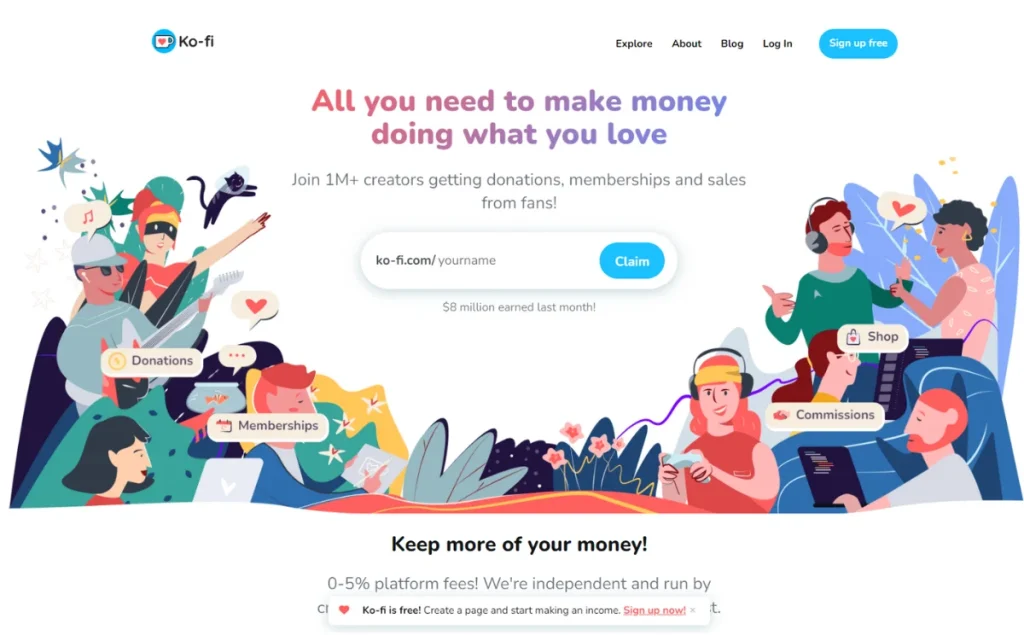
What is Patreon?
Patreon is among the sites like Ko-fi that are widely popular and designed for creators to monetize content via a membership.
What is Patreon Used For?
You can use Patreon for:
- Selling membership tiers: Set various price points and reward systems, allowing you to receive recurring payments from your supporters.
- Offering exclusive content: Create and give fans access to your member-only content and offer them benefits such as early access to new work, behind-the-scenes content, and exclusive merch.
How Much Does Patreon Take?
Patreon has different creators’ membership tiers, incurring different percentage fees (plus payment processing and taxes).
Check them out below:
- For the Founders plan (creators who joined before May 2019), Patreon takes 5% of your total earnings.
- With the Pro plan, Patreon receives 8% of your total income.
- Finally, the Premium plan charges 12% of Patreon’s earnings.

What is Hello Audio? [A Perfect Alternative]
Hello Audio is the leading podcast hosting platform that lets you create, host, distribute, manage, and monetize your private podcasts.
What is Hello Audio Used For?
Whether it’s a digital course, call recordings, meetings, or event replays, you can repurpose content into private podcasts and let your audience listen to them anytime, anywhere.
Your audience can listen to the private audio content directly on their phone via their favorite listening apps, such as Apple Podcasts, Google Podcasts, Spotify, or others.
Benefits of Hello Audio for Creators
How does Hello Audio stack up against Ko-fi and Patreon?
Check out a list of benefits you stand to gain as a creator with Hello Audio:
- Upload your video and audio files to our platform, and they’ll be converted into private podcasts—in minutes.
- Members can access your private audio feeds in their favorite apps, such as Spotify, Apple Podcasts, and Overcast.
- Access detailed analytics of each episode and use the insights to adjust your content accordingly.
- Diversify your income by creating exclusive and member-only private audio feeds.
- Manage your members’ access (grant or revoke permissions) to your exclusive content.
- Segment your content with tags to deliver targeted content.
Inspired?
Take a free tour and get firsthand experience of Hello Audio features.
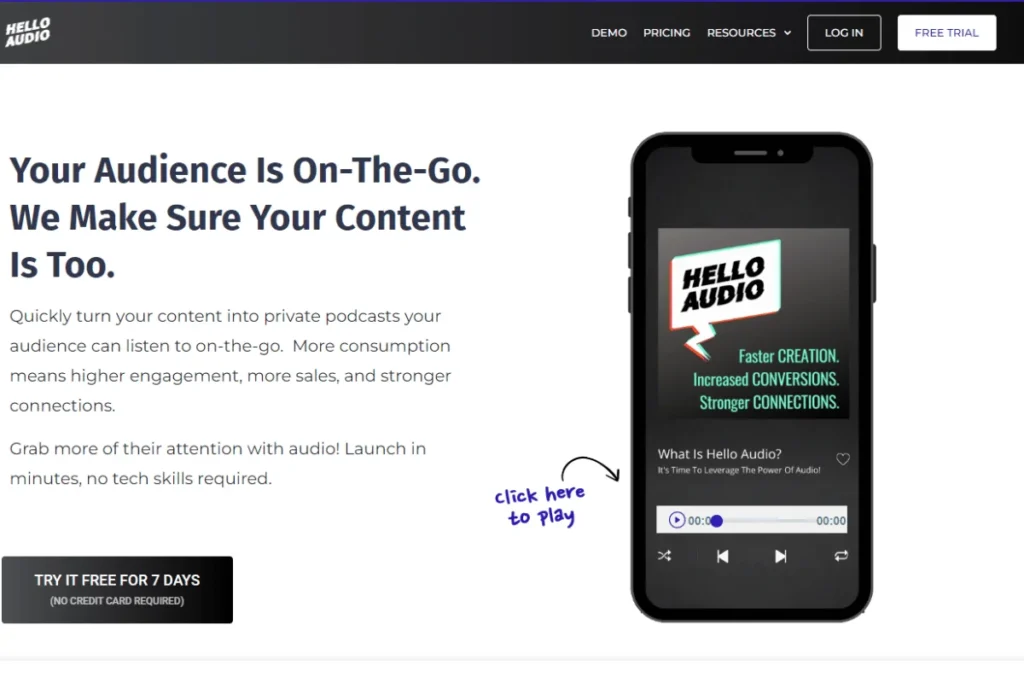
Relevant Characteristics Between Ko-fi and Patreon
Is Ko-fi better than Patreon?
Here’s a quick overview of the two platforms to help you choose the best one:
| Ko-fi | Patreon | |
|---|---|---|
| Fee Structure | 5% on shop sales and memberships or $6 per month for Ko-fi Gold plan | 5 to 12% of your income, depending on your plan |
| Support | Provides a Creator Academy and allows you to submit requests on the web form | Provides a knowledge base, email support, and customer support |
| Customization | Limited customization features like setting a cover image, a social preview image, information on your product page, or custom colors for the Gold plan | Limited customization options like adding a profile and cover image and changing your page colors |
| Community Engagement | Has engagement features like customized messages | Offers engagement tools like comments, DMs, and chats |
| Platform Reach | Only available on desktop | Available on desktop, iOS, and Android |
| Ease of Use | Easy to set up and start | A bit complex for newbies |
| Payout Frequency | Instant cash out is available | Cash-out monthly |
| Monetization Options | Sell merch, set crowdfunding goals, receive donations, sell commissions and membership subscriptions | Offer paid membership and sell digital products |
Similarities and Differences
Here is the deal — some features are similar on the two platforms, and some are not.
Find out more in the following sections.
Ko-fi and Patreon Differences
Want to learn the differences between Patreon vs. Ko-fi?
Here are the 6 ways they vary:
- Fees: Patreon takes up to 12% of your income, while Ko-fi charges 5% platform fees. You can also opt for the $6 monthly Gold plan.
- Minimum balance: If you’re a creator on Patreon, you must keep a minimum balance between $10 and $25 (depending on your region). However, in Ko-fi, you don’t need a minimum balance in your account.
- Devices: You can only use Ko-fi on desktops, but you can’t use it on Android/ iOS devices. Unlike Ko-fi, you can access Patreon on your desktop and mobile too.
- Commitment to publishing content: As a creator on Patreon, you have to publish content monthly, while on Ko-fi, you can decide to post as little or as much content as you want.
- Creators membership tiers: Ko-fi offers three low-priced membership options: Free, Contributor, and Gold.
Patreon offers three plans: Founder, Pro, and Premium, and takes 5%, 8%, and 12% of your total income, respectively.
- Instant and direct payments: On Ko-fi, you can withdraw the money you’ve earned immediately, while on Patreon, you can only withdraw your earnings at the end of the month.
Patreon and Ko-fi Similarities
Now, let’s look at the similarities between the two platforms:
- Built-in payment systems: Both platforms allow you to receive payments via Venmo, PayPal, Apple Pay, and others.
- Subscriptions: Patreon and Ko-fi let you set up different membership tiers so your supporters can access exclusive content.
- Supporters-only benefits: Both tools let you offer unique benefits like exclusive content, Discord roles, and more.
- Posts and updates: These platforms allow you to update your followers with photos and videos and let you schedule posts.
Enjoying this post? You may also like our other comparison articles:

What About Hello Audio?
With the current podcast surge, you need a reliable platform to create, host, and manage your private podcasts.
Hello Audio does just that!
Use Hello Audio to Host Private Podcasts
Looking for the best hosting solution for your private audio content? Look no further.
Check out some quick, unique features of Hello Audio for creators:
- User-friendly and easy-to-use dashboard: Drag and drop your existing content — digital courses, coaching recordings, audiobooks, TikTok videos — and our platform will convert it into private podcasts in minutes.
- Secure and exclusive access: Control who has access to your private audio content.
- Auto-publish your private content with a click: Automatically sends the private audio feeds to podcast directories like Spotify and Apple Podcasts.
- Monetize your podcasts: Hello Audio integrates seamlessly with Stripe, allowing you to collect subscription payments from your listeners for access to exclusive podcasts.
- Automate the management of your subscribers: Thanks to the Zapier integration with Hello Audio, you can manage your subscribers without lifting a finger. The integration allows you to automatically send out subscribe links, add or remove listeners, and trigger actions based on your listeners’ behavior.
- Schedule audio content: Set the release date of an episode to a future date or schedule the release of dripped audio content.

Bottom Line
Now that you know the features of both tools, you can decide which one you prefer.
Choose Patreon if you create content regularly and offer monthly memberships. Opt for Ko-fi if you want to post content when it’s convenient, enjoy low fees, and receive one-off donations.
If you want a versatile platform for creating, managing, and monetizing private podcasts, try Hello Audio.
With Hello Audio, you don’t need to create content from scratch. You can repurpose existing video and audio content into private audio feeds. You can also manage access and monitor your listeners’ analytics per episode, ensuring you get detailed insights to scale your business.
Why not sign up for a 7-day free trial and create your first private podcast in minutes?
Frequently Asked Questions (FAQs)
Still confused about Patreon or Ko-fi?
Check out some answers to commonly asked questions.
How Do the Analytics and Reporting Tools Compare on Ko-fi and Patreon?
Ko-fi offers basic analytics, like monitoring past and upcoming orders. The Ko-fi Gold package lets you link your page to Google Analytics and track the bounce rate, views, clicks, and other metrics.
On the other hand, Patreon offers more detailed analytics, such as your patrons’ growth, number of impressions, and earnings. You can also integrate Ko-fi with Google Analytics.
Can Creators on Ko-fi Offer Exclusive Content Like Patreon?
Yes. Like Patreon, Ko-fi creators can share art commissions, images, digital files, videos, or posts exclusively with their one-off donors or monthly supporters.
What Types of Creators are Best Suited for Ko-fi vs. Patreon?
Ko-fi is ideal for creators who post their content casually, while Patreon is perfect for creators who post their content consistently, whether daily or monthly.

